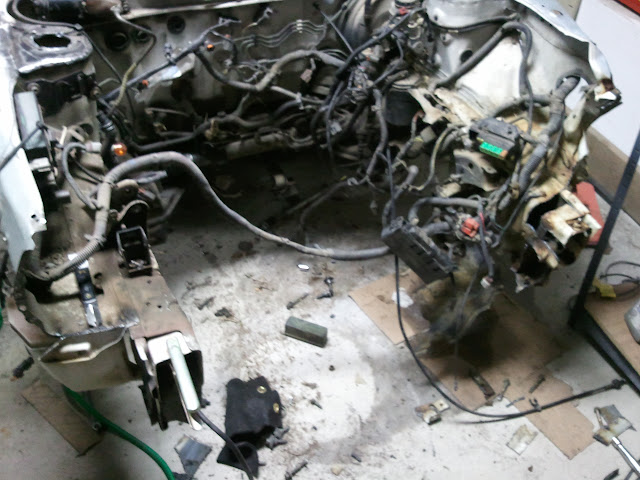
1. Subscribed.
2. DId you figure out what you are going to do with your transmission? If not, ask, we may be able to help.
3. Interested in your rear link solution. Note that from Road Racing experience in the forums, it was not the parallel ones that were the major problem but the trailing link.
For now, I'm just running a stock B13 transmission. I'm interested in hearing options.
As to the rear suspension, it's not just the trailing arm or the parallel arms that bind, it's all of it. The rear suspension on the B13 operates almost entirely in bind, and depends on the compliance of bushings to make it work.
As the wheels go up and down they get pulled front-back by the trailing arm's arc. That requires the parallel arms to flex at the body and at the knuckle.
As the wheels go up and down, they also get pulled in and pushed out by the arc of the parallel arms. This requires flex at the ends of the trailing arm, both at the body (large bushing) and at the knuckle (small bushing).
With the limited stock travel, the soft stock bushings allow for this flex. The problem is that they also allow for the wheel to move in less controlled ways as the bushings deform in other ways than simply pivoting. This means that the alignment of the rear wheels is constantly changing under load. To try and address this, people put in poly bushings, which have much less compliance.
This causes the binding to become much worse (though I'm of the opinion that it's not really as big a deal under typical circumstances as some make it out to be).
The "fix" of leaving the stock front bushing in the trailing arm helps in two ways. One, because the bushing is soft rubber, it will deform in such a way as to allow some fore-aft movement of the arm, which the poly bushing doesn't. Two, because the ES bushing is so wide that it makes contact with the body mounts across the face of the bushing (not just at the metal sleeve), it's resistance to flex is well above the difference between the rubber and the poly materials. I think this bushing is a poor design on ES's part.
The problem with the fix is that it requires the trailing arm to move in ways it was never supposed to move, and puts all the binding stresses on that one bushing. But it works for most, and even as a compromise, it's better than stock for track use.
Now, add more range of motion to the suspension, and things get really ugly, because the farther you move the wheel up and down the more the arcs of the arms pull the wheels in and forward. Since my rear suspension has massively more travel than stock, I see binding bad enough that the bushing prevent droop about 2-3" (!) before the struts do. Not only is that wasting travel that I could be using, it also means that the suspension will behave in a very non-linear fashion.
The ideal solution would be to replace all of the bushings with rod ends and allow full articulation, with 100% compliance in the directions required and 0% in those not. Offhand, I'm not sure how to make that a reality, but here's what I'm doing.
1. New parallel arms with heim joints at each end (this has the side benefit of allowing for length adjustment of the arms, but that isn't the main goal). This takes all the bind out of the parallel arms, and allows them to move fore-aft smoothly, without requiring the front trailing arm bushing to compress.
2. I will initially shave the front trailing arm bushing (using the ES poly one) to allow the arm to pivot more freely, while maintaining the higher level of control of the poly bushing in compression (fore-aft movement). I actually have the rod ends and tube adapters I need to convert this joint to a heim joint as well, but not enough time to take that on before the first event.
That leave the bushing in the knuckle, and that's the hard part. If the bushing was in the arm, it would be no problem at all to replace with a heim joint, but as it's in the knuckle, it's a pain. I'm sure someone with mad fab skills could come up with a way to machine the hub and press in a ball-type bushing, or perhaps remove the current attachment point entirely and thread the knuckle for a ball joint. but I haven't come up with a brilliant plan that fits my fab skills yet. It's possible that between the parallel arms and the shaved front bushing, I'll never need to go further; there would still be some bind, but it may be minimal.








 Be the first to like this post.
Be the first to like this post.




 Back to top
Back to top
